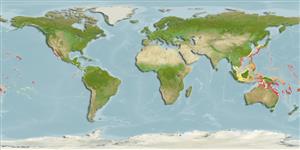Environment: milieu / climate zone / depth range / distribution range
Écologie
marin récifal; profondeur 4 - 30 m (Ref. 90102). Tropical
Western Pacific: Philippines and Taiwan to Fiji, north to the Izu Islands, south to the Great Barrier Reef and New Caledonia. Recently recorded from Tonga (Ref. 53797).
Taille / Poids / Âge
Maturity: Lm ? range ? - ? cm
Max length : 20.0 cm SL mâle / non sexé; (Ref. 9823)
Épines dorsales (Total) : 9; Rayons mous dorsaux (Total) : 11 - 13; Épines anales: 3; Rayons mous anaux: 11 - 13. Head spotted. Color of females black dorsally, blue spotted, becoming yellowish white on sides and white ventrally; opercle with a large black ocellus; anal fin with a broad black band. Male form blackish dorsally with light blue dots, shading gradually to light yellowish green; each body scale with vertical light blue line; upper half of head dark reddish with dark-edged blue bands radiating from eye; anal fins with several longitudinal bands on a broad orange zone; caudal fin with vertical stripes. Dorsal spines pungent.
An inshore species inhabiting shallow coral reefs (Ref. 9823), with patches of sand and rubble (Ref. 37816), also along upper part of slopes and on reef crests with Acropora corals. Adults occur in small loose groups of females with dominant male nearby. Juveniles occur solitary in corals (Ref. 48636). Feed on benthic invertebrates. Oviparous, distinct pairing during breeding (Ref. 205). Occasionally seen in fish markets and aquarium trade.
Life cycle and mating behavior
Maturities | Reproduction | Spawnings | Egg(s) | Fecundities | Larves
Oviparous, distinct pairing during breeding (Ref. 205).
Westneat, M.W., 2001. Labridae. Wrasses, hogfishes, razorfishes, corises, tuskfishes. p. 3381-3467. In K.E. Carpenter and V. Niem (eds.) FAO species identification guide for fishery purposes. The living marine resources of the Western Central Pacific. Vol. 6. Bony fishes part 4 (Labridae to Latimeriidae), estuarine crocodiles. FAO, Rome. (Ref. 9823)
Statut dans la liste rouge de l'IUCN (Ref. 130435)
Menace pour l'homme
Harmless
Utilisations par l'homme
Pêcheries: intérêt commercial mineur; Aquarium: Commercial
Outils
Articles particuliers
Télécharger en XML
Sources Internet
Estimates based on models
Preferred temperature (Ref.
123201): 24.6 - 29.3, mean 28.4 °C (based on 1821 cells).
Phylogenetic diversity index (Ref.
82804): PD
50 = 0.5002 [Uniqueness, from 0.5 = low to 2.0 = high].
Bayesian length-weight: a=0.00977 (0.00470 - 0.02030), b=3.07 (2.89 - 3.25), in cm total length, based on LWR estimates for this (Sub)family-body shape (Ref.
93245).
Niveau trophique (Ref.
69278): 3.5 ±0.37 se; based on food items.
Résilience (Ref.
120179): Milieu, temps minimum de doublement de population : 1,4 à 4,4 années (Preliminary K or Fecundity.).
Fishing Vulnerability (Ref.
59153): Low vulnerability (14 of 100).
Nutrients (Ref.
124155): Calcium = 68.7 [41.1, 112.0] mg/100g; Iron = 0.64 [0.38, 1.17] mg/100g; Protein = 18.5 [15.7, 20.7] %; Omega3 = 0.149 [0.098, 0.227] g/100g; Selenium = 23.7 [14.5, 41.8] μg/100g; VitaminA = 143 [45, 518] μg/100g; Zinc = 1.58 [1.11, 2.47] mg/100g (wet weight);
